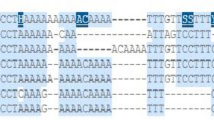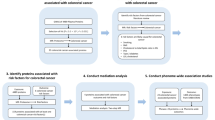Abstract
The objective was to analyze the relation between gastric cancer susceptibility and gene polymorphism, providing a reference for epidemiologic research of gastric cancer etiology. Two hundred and eighty gastric cancer cases were selected, and 280 healthy cases with the same gender, age (±5), and residence place were selected as control group, with proportion of 1:1. Tag single nucleotide polymorphism was used for screening polymorphism of caspase3, which was combined with logistic regression model and multi-point joint analysis to analyze relation between different genotypes and gastric susceptibility. In analysis of gene polymorphism of caspase3 intrinsic apoptotic pathway and gastric cancer susceptibility, polymorphism of CASP3 rs4647693, CASP3 rs12108497 and CASP3 rs4647610 increased gastric cancer risk (rs4647693: ORGA 1.61, 95 % CI 1.06–2.28; rs12108497: ORTC 1.55, 95 % CI 1.09–2.18; ORCC 2.45, 95 % CI 1.08–4.16; rs4647610: ORAG 1.71, 95 % CI 1.14–2.31; ORGG 1.60, 95 % CI 1.23–2.34). Gastric cancer risk of haplotype AGGC carrier was significantly higher than that of haplotype GGAT as control (OR 1.44, 95 % CI 1.07–2.19). Gene polymorphism and haplotype of caspase3 can increase gastric cancer risk. However, it still needs to be verified by a large-sample and multicenter epidemiologic research.
Similar content being viewed by others
References
Ema, A., Yamashita, K., Sakuramoto, S., Wang, G., Mieno, H., Nemoto, M., et al. (2014). Lymph node ratio is a critical prognostic predictor in gastric cancer treated with S-1 chemotherapy. Gastric Cancer Official Journal of the International Gastric Cancer Association and the Japanese Gastric Cancer Association, 17(1), 67–75. Epub 2013/06/27.
Paoletti, X., Oba, K., Burzykowski, T., Michiels, S., Ohashi, Y., Pignon, J. P., et al. (2010). Benefit of adjuvant chemotherapy for resectable gastric cancer: A meta-analysis. JAMA, the Journal of the American Medical Association, 303(17), 1729–1737. Epub 2010/05/06.
Ma, J. L., Zhang, L., Brown, L. M., Li, J. Y., Shen, L., Pan, K. F., et al. (2012). Fifteen-year effects of Helicobacter pylori, garlic, and vitamin treatments on gastric cancer incidence and mortality. Journal of the National Cancer Institute, 104(6), 488–492. Epub 2012/01/25.
Wang, K., Kan, J., Yuen, S. T., Shi, S. T., Chu, K. M., Law, S., et al. (2011). Exome sequencing identifies frequent mutation of ARID1A in molecular subtypes of gastric cancer. Nature Genetics, 43(12), 1219–1223. Epub 2011/11/01.
Singh, B. N., Kumar, D., Shankar, S., & Srivastava, R. K. (2012). Rottlerin induces autophagy which leads to apoptotic cell death through inhibition of PI3K/Akt/mTOR pathway in human pancreatic cancer stem cells. Biochemical Pharmacology, 84(9), 1154–1163. Epub 2012/08/21.
Moon, S. M., Yun, S. J., Kook, J. K., Kim, H. J., Choi, M. S., Park, B. R., et al. (2013). Anticancer activity of Saussurea lappa extract by apoptotic pathway in KB human oral cancer cells. Pharmaceutical Biology, 51(11), 1372–1377. Epub 2013/07/17.
Potthoff, A., Ledig, S., Martin, J., Jandl, O., Cornberg, M., Obst, B., et al. (2002). Significance of the caspase family in Helicobacter pylori induced gastric epithelial apoptosis. Helicobacter, 7(6), 367–377.
Dai, Z. J., Gao, J., Ji, Z. Z., Wang, X. J., Ren, H. T., Liu, X. X., et al. (2009). Matrine induces apoptosis in gastric carcinoma cells via alteration of Fas/FasL and activation of caspase-3. Journal of Ethnopharmacology, 123(1), 91–96.
Luo, C., Zhu, Y., Jiang, T., Lu, X., Zhang, W., Jing, Q., et al. (2007). Matrine induced gastric cancer MKN45 cells apoptosis via increasing pro-apoptotic molecules of Bcl-2 family. Toxicology, 229(3), 245–252.
Yan, F., He, Q., Hu, X., Li, W., Wei, K., Li, L., et al. (2013). Direct regulation of caspase3 by the transcription factor AP2alpha is involved in aspirininduced apoptosis in MDAMB453 breast cancer cells. Molecular Medicine Reports, 7(3), 909–914. Epub 2013/01/08.
Soung, Y. H., Lee, J. W., Kim, S. Y., Park, W. S., Nam, S. W., Lee, J. Y., et al. (2004). Somatic mutations of CASP3 gene in human cancers. Human Genetics, 115(2), 112–115. Epub 2004/05/06.
Kuo, H. C., Yu, H. R., Juo, S. H., Yang, K. D., Wang, Y. S., Liang, C. D., et al. (2011). CASP3 gene single-nucleotide polymorphism (rs72689236) and Kawasaki disease in Taiwanese children. Journal of Human Genetics, 56(2), 161–165. Epub 2010/12/17.
Chen, K., Zhao, H., Hu, Z., Wang, L. E., Zhang, W., Sturgis, E. M., et al. (2008). CASP3 polymorphisms and risk of squamous cell carcinoma of the head and neck. Clinical Cancer Research: An Official Journal of the American Association for Cancer Research, 14(19), 6343–6349.
Onouchi, Y., Suzuki, Y., Suzuki, H., Terai, M., Yasukawa, K., Hamada, H., et al. (2013). ITPKC and CASP3 polymorphisms and risks for IVIG unresponsiveness and coronary artery lesion formation in Kawasaki disease. The Pharmacogenomics Journal, 13(1), 52–59. Epub 2011/10/12.
Guan, X., Liu, Z., Liu, H., Yu, H., Wang, L. E., Sturgis, E. M., et al. (2013). A functional variant at the miR-885-5p binding site of CASP3 confers risk of both index and second primary malignancies in patients with head and neck cancer. FASEB Journal: Official Publication of the Federation of American Societies for Experimental Biology, 27(4), 1404–1412.
Yang, L. Q., Fang, D. C., Wang, R. Q., & Yang, S. M. (2004). Effect of NF-kappaB, survivin, Bcl-2 and Caspase3 on apoptosis of gastric cancer cells induced by tumor necrosis factor related apoptosis inducing ligand. World Journal of Gastroenterology: WJG, 10(1), 22–25. Epub 2003/12/27.
Soung, Y. H., Lee, J. W., Kim, S. Y., Jang, J., Park, Y. G., Park, W. S., et al. (2005). CASPASE-8 gene is inactivated by somatic mutations in gastric carcinomas. Cancer Research, 65(3), 815–821. Epub 2005/02/12.
Li, Y. H., Wang, C., Meng, K., Chen, L. B., & Zhou, X. J. (2004). Influence of survivin and caspase-3 on cell apoptosis and prognosis in gastric carcinoma. World Journal of Gastroenterology: WJG, 10(13), 1984–1988.
Park, H. J., Kim, Y. J., Leem, K., Park, S. J., Seo, J. C., Kim, H. K., et al. (2005). Coptis japonica root extract induces apoptosis through caspase3 activation in SNU-668 human gastric cancer cells. Phytotherapy Research: PTR, 19(3), 189–192.
Wong, B. C., Lam, S. K., Wong, W. M., Chen, J. S., Zheng, T. T., Feng, R. E., et al. (2004). Helicobacter pylori eradication to prevent gastric cancer in a high-risk region of China: A randomized controlled trial. JAMA the Journal of the American Medical Association, 291(2), 187–194.
Yang, L. (2006). Incidence and mortality of gastric cancer in China. World Journal of Gastroenterology: WJG, 12(1), 17–20.
Inoue, M., & Tsugane, S. (2005). Epidemiology of gastric cancer in Japan. Postgraduate Medical Journal, 81(957), 419–424.
Shin, C. M., Kim, N., Lee, H. S., Lee, D. H., Kim, J. S., Jung, H. C., et al. (2011). Intrafamilial aggregation of gastric cancer: a comprehensive approach including environmental factors, Helicobacter pylori virulence, and genetic susceptibility. European Journal of Gastroenterology and Hepatology, 23(5), 411–417. Epub 2011/04/20.
Marcos-Pinto, R., Dinis-Ribeiro, M., Carneiro, F., Machado, J. C., Figueiredo, C., Reis, C. A., et al. (2012). First degree relatives and familial aggregation of gastric cancer: who to choose for control in case-control studies? Familial Cancer, 11(1), 137–143.
Dhillon, P. K., Farrow, D. C., Vaughan, T. L., Chow, W. H., Risch, H. A., Gammon, M. D., et al. (2001). Family history of cancer and risk of esophageal and gastric cancers in the United States. International Journal of Cancer, 93(1), 148–152.
Hosgood, H. D., 3rd, Baris, D., Zhang, Y., Zhu, Y., Zheng, T., Yeager, M., et al. (2008). Caspase polymorphisms and genetic susceptibility to multiple myeloma. Hematological Oncology, 26(3), 148–151.
Kinslow, C. J., El-Zein, R. A., Hill, C. E., Wickliffe, J. K., & Abdel-Rahman, S. Z. (2008). Single nucleotide polymorphisms 5′ upstream the coding region of the NEIL2 gene influence gene transcription levels and alter levels of genetic damage. Genes, Chromosomes and Cancer, 47(11), 923–932.
Jang, J. S., Kim, K. M., Choi, J. E., Cha, S. I., Kim, C. H., Lee, W. K., et al. (2008). Identification of polymorphisms in the Caspase-3 gene and their association with lung cancer risk. Molecular Carcinogenesis, 47(5), 383–390.
Shao, X. D., Wu, K. C., Guo, X. Z., Xie, M. J., Zhang, J., & Fan, D. M. (2008). Expression and Significance of HERG Protein in Gastric Cancer. Cancer Biology & Therapy, 7(1), 45–50.
Sun, Y., Chen, X. Y., Liu, J., Cheng, X. X., Wang, X. W., Kong, Q. Y., et al. (2006). Differential caspase-3 expression in noncancerous, premalignant and cancer tissues of stomach and its clinical implication. Cancer Detection and Prevention, 30(2), 168–173.
Kasper, G., Reule, M., Tschirschmann, M., Dankert, N., Stout-Weider, K., Lauster, R., et al. (2007). Stromelysin-3 over-expression enhances tumourigenesis in MCF-7 and MDA-MB-231 breast cancer cell lines: involvement of the IGF-1 signalling pathway. BMC Cancer, 7, 12.
Author information
Authors and Affiliations
Corresponding author
Rights and permissions
About this article
Cite this article
Li, B., Liu, H., Gong, F. et al. Molecular Epidemiologic Correlation Analysis Between Caspase3 Gene Polymorphism and Gastric Cancer Susceptibility. Cell Biochem Biophys 70, 1647–1653 (2014). https://doi.org/10.1007/s12013-014-0108-0
Published:
Issue Date:
DOI: https://doi.org/10.1007/s12013-014-0108-0




